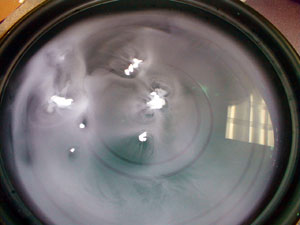Model comets with dry ice

Bits of dry ice outgas and propel themselves around on the
surface tension of warm water.
Model comets with dry ice

Bits of dry ice outgas and propel themselves around on the
surface tension of warm water.
Material
Assembly
Place the warm water into the tray until it is several centimeters deep.
Wrap the dry ice in a towel and pound it with a hammer to create small pieces.
To Do and Notice
Put a small piece of dry ice into the warm water.
The piece should be just small enough that it stays on the surface of the water. Larger pieces will sink.
Notice that the dry ice skitters around on the surface of the water, and that it is surrounded by a cloud. The cloud may have a spiral structure if the particle of dry ice spins.
Notice that a dry ice particle bounces off the walls of the tray.
Notice that two dry ice particles attract each other, and stick together.
What's Going On?
Dry ice sublimes, i.e. it turns directly from a solid to a gas.
The gas then shoots out, creating a dimple in the surface of the water so that the surface tension of the water can support the particle of dry ice. The dry ice is actually denser than water and will sink if it is not supported by surface tension.
The escaping gas pushes the dry ice particles around and makes them spin with rocket propulsion.
The escaping gas is cold and so it creates a cloud of water droplets in the vicinity of the dry ice particle.
At the edges of the tank the water rises up the plastic in a meniscus. The dry ice particles collide with the meniscus, rising up its gentle curve and then sliding back down. This gives them a nice elastic bounce off the sides of the tank.
The dry ice particles fall into the depressions around other dry ice particles. So they seem to attract each other and stick together. (I call this the "valley bed" analogy.)
So What
Comets contain ices which sublime into the vacuum of space. These gasses, and the dust they expel, create the beautiful tails of comets. This exploration produces tails of water droplets which are reminiscent of the tails of comets.
References
This exploration is based on an original exhibit created by Shawn Lani which is on display at the Chabot Science Center.
|
Scientific Explorations with Paul Doherty |
|
10 July 2002 |